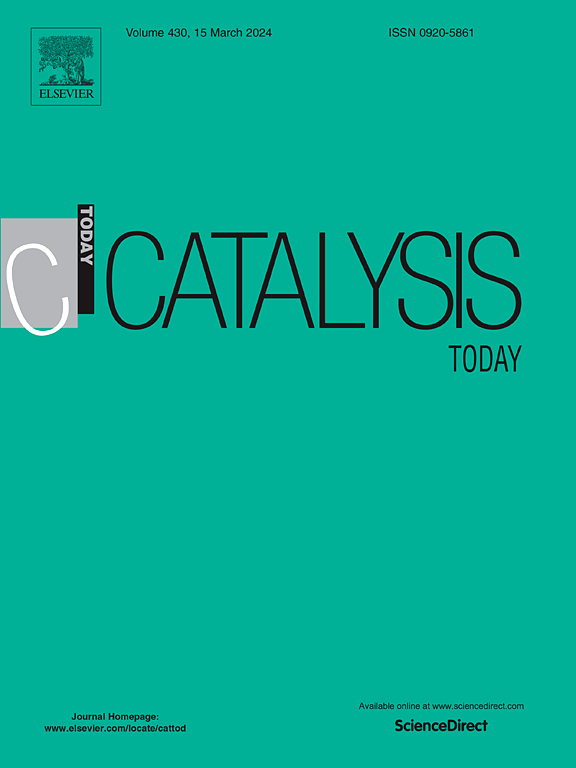Sulfur-doped carbon/TiO2 composites for ethylene photo-oxidation. Enhanced performance by doping TiO2 phases with sulfur by mobile species inserted on the carbon support
IF 5.2
2区 化学
Q1 CHEMISTRY, APPLIED
引用次数: 0
Abstract
The performance of carbon xerogel/TiO2 composites in ethylene photo-oxidation was analyzed under dynamic conditions considering various parameters, namely sulfur doping, dry vs. humid conditions and type of radiation (ultraviolet, UV, vs. visible light, Vis). The catalysts were synthesized using an acid-catalyzed sol-gel process and characterized with complementary techniques, including SEM/EDX, XRD, XPS and physical adsorption of N2 and CO2, among others. The performance of samples in ethylene removal by adsorption and photo-oxidation under dynamic flow was discussed and related with their physicochemical properties and the experimental conditions. Although ethylene adsorption was hindered by doping and humidity, both factors were found to enhance photoactivity by promoting the formation of highly oxidant hydroxyl radicals (HO•). The composites showed an improved catalytic performance compared to bare TiO2, with sulfur improving the activity by approximately 8 %. The presence of the carbon material also enhanced the performance under Vis radiation by nearly 25 %. It was suggested that sulfur species could migrate from the carbon support to the TiO2 nanoparticles during carbonization, forming Ti-O-S bonds. This finding constitutes a novel, cost-effective, sustainable and scalable method for the preparation of supported and doped TiO2 nanocomposites.
用于乙烯光氧化的掺硫碳/二氧化钛复合材料。通过在碳载体上插入流动物种在二氧化钛相中掺入硫来提高性能
考虑到各种参数,即硫掺杂、干燥与潮湿条件以及辐射类型(紫外线与可见光),在动态条件下分析了碳 xerogel/TiO2 复合材料在乙烯光氧化中的性能。催化剂采用酸催化溶胶-凝胶工艺合成,并通过 SEM/EDX、XRD、XPS 以及 N2 和 CO2 物理吸附等辅助技术进行表征。讨论了样品在动态流动条件下通过吸附和光氧化去除乙烯的性能,并将其与样品的理化性质和实验条件联系起来。虽然掺杂和湿度阻碍了乙烯的吸附,但这两个因素都促进了高氧化性羟基自由基(HO-)的形成,从而提高了光活性。与裸 TiO2 相比,复合材料的催化性能有所提高,其中硫的活性提高了约 8%。碳材料的存在也将 Vis 辐射下的性能提高了近 25%。研究表明,在碳化过程中,硫元素可从碳支撑迁移到二氧化钛纳米颗粒,形成 Ti-O-S 键。这一发现为制备支撑和掺杂二氧化钛纳米复合材料提供了一种新颖、经济、可持续和可扩展的方法。
本文章由计算机程序翻译,如有差异,请以英文原文为准。
求助全文
约1分钟内获得全文
求助全文
来源期刊

Catalysis Today
化学-工程:化工
CiteScore
11.50
自引率
3.80%
发文量
573
审稿时长
2.9 months
期刊介绍:
Catalysis Today focuses on the rapid publication of original invited papers devoted to currently important topics in catalysis and related subjects. The journal only publishes special issues (Proposing a Catalysis Today Special Issue), each of which is supervised by Guest Editors who recruit individual papers and oversee the peer review process. Catalysis Today offers researchers in the field of catalysis in-depth overviews of topical issues.
Both fundamental and applied aspects of catalysis are covered. Subjects such as catalysis of immobilized organometallic and biocatalytic systems are welcome. Subjects related to catalysis such as experimental techniques, adsorption, process technology, synthesis, in situ characterization, computational, theoretical modeling, imaging and others are included if there is a clear relationship to catalysis.
 求助内容:
求助内容: 应助结果提醒方式:
应助结果提醒方式:


